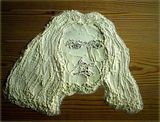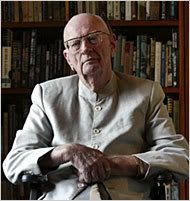
Tuesday, December 30, 2008
Sunday, December 21, 2008
Saturday, December 20, 2008
Wednesday, December 10, 2008
Bruce Lee Ping Pong
Friday, December 05, 2008
Let it snow!
Thursday, December 04, 2008
The Pen is Mightier than the Sword

Here's Gary's latest animation!
Sunday, November 30, 2008
Encryption for Laptops
"Having your laptop stolen can ruin your whole week. Hopefully, by now, you’re backing it up regularly and you know that there’s software available that can dramatically improve the odds of getting your computer back. But perhaps the creepiest aspect of having your laptop stolen is that someone might be going through the information you have on it: Email, contact lists, web browsing history, passwords, financial information, family photos and, if you use the computer for work, potentially sensitive business information....
There are a lot of different encryption products available to protect data on your laptop. But, sadly, many of them dive quickly into technical details and scare most people off. So, while I’d be happy to answer your technical or security questions , I’m going to avoid all that and just tell you what you need: Full disk encryption software or FDE, for short."
Click the title bar to read the entire article on 'TechLife Post'.
Thursday, November 20, 2008
Nov. 20, 1820: One Whale Exacts His Revenge
Click the title to read the entire story
Wednesday, November 19, 2008
Mickey Mouse turns 80
Saturday, November 15, 2008
Top 5 Science Conspiracies, Theories and Hoaxes
Thursday, November 13, 2008
'Buddha Boy' returns
"They asked not where he had been or what he had been doing. Instead thousands of jubilant devotees simply trudged to the remote jungle spot in south-east Nepal where a teenage "Buddha Boy" reappeared to preach to villagers, more than a year after he went missing.

Ram Bahadur Bamjon became famous three years ago when tens of thousands of people flocked to watch him sitting cross-legged under a tree for almost ten months. His followers - who say he is the reincarnation of Buddha - claimed that during this time he neither ate nor drank.
Then, last spring, his supporters said that the teenager was planning to go away and meditate for three years in an underground bunker. He was last seen in August 2007, preaching to crowds in Nepal’s Hallori jungle, around 100 miles south of Kathmandu.
Whatever encouraged Mr Bamjon to re-emerge is unclear, but police said that on Monday he appeared, long-haired, dressed in white and looking in good health, and preached to villagers for around 45 minutes. Local officials said he plans to speak to people for an hour a day for another week.
"Hundreds of devotees, including many from neighbouring India are trekking the five kilometres to see him," said one police officer, Prakash Sen. "He spoke to the devotees standing near a temple in the forest. He had shoulder-length hair and had his body wrapped in a white cloth. Since many people are walking to see him, I think he has some of the qualities Lord Buddha had."
When Mr Bamjon first became famous reporters filmed him eating, even though his supporters said he could go without food or drink for days. He was also spotted sleeping when his followers said he was meditating in private. However, a number of witnesses spoke of the young man’s ability to sit fixed in one spot for hours on end
There has been no formal declaration by Buddhist authorities on whether they consider the teenager to be the reincarnation of Siddhartha Gautama, who was born in south-western Nepal in 500 BC and later became revered as the Buddha, or "Enlightened One". Buddhist priests have been divided on the issue, despite the claims of his followers. Meanwhile local volunteers have collected thousands of dollars from people who have visited the young man, prompting accusations that he is merely at the centre of a clever and enlightened money-making scam."
Search on 'buddha boy'in search box at top left to find previous blog entries
Saturday, November 08, 2008
Monday, November 03, 2008
Marty Reisman, table tennis great
If you don't recognize him, this is the great Marty Reisman...one-time #3 in
the world. I took my very first TT lesson from him at age 16, some 36 years ago now.
Here he is in his late 70's, demonstrating his accuracy by smashing cigarettes in half.
He hasn't lost too much!:
Don't believe the closeness of the score. When he published his autobiography, The Money Player: The confessions of America's greatest table tennis champion and hustler, he had an exhibition at Macy's department store in the 70's to launch his book.
My father Alan and I were very friendly with Marty at that time, being regulars at his club on 96th Street in Manhattan. In fact, he let us read the manuscript prior to publication and gave us an autographed copy upon its publication. Anyway, at Macy's he took on all comers -- spotting them points -- and would give a free book to anyone who could beat him in a game (he only gave away one).
I remember that he and I played an abbreviated game to 15, which he *won* by only two points (I don't recall now how many points he spotted me...probably 8...but somehow, he always seemed to win by only 2 points), and finished me off with the drop shot you see on the last shot in the video above.
My father, who competed late in the exhibition, was up by a point when Marty used his infamous drop shot. Having seen it all afternoon, my father was prepared and ran to the side of the table, smashed the ball with all of his might, and ended up standing next to Marty on his side of the table....having won the point and the game.
I won't say that Marty was upset exactly, but one could tell he wasn't very pleased. And so, you now know why I have two copies of The Money Player!
Greatest table tennis match
Thursday, October 30, 2008
Wednesday, October 22, 2008
Sunday, October 19, 2008
Monday, September 08, 2008
Dolphin rings
Just another of many indications of their advanced intelligence.
"I HOPE YOU LIKE THIS - IT IS BEAUTIFUL! I CAN'T SPEAK FOR THE
'EXPLANATION' BELOW.
==============================================================
The attached video is of dolphins playing with silver colored rings
which they have the ability to make under water to play with. It isn't
known how they learn this, or if it's an inbred ability.
As if by magic the dolphin does a quick flip of its head and a silver
ring appears in front of its pointed beak. The ring is a solid, donut
shaped bubble about 2-ft across, yet it doesn't rise to the surface of the
water! It stands upright in the water like a magic doorway to an unseen
dimension. The dolphin then pulls a small silver donut from the larger
one. Looking at the twisting ring for one last time a bite is taken
from it, causing the small ring to collapse into a thousands of tiny
bubbles which head upward towards the water's surface. After a few
moments the dolphin creates another ring to play with. There also
seems to be a separate mechanism for producing small rings, which a
dolphin can accomplish by a quick flip of its head.
An explanation of how dolphins make these silver rings is that they
are "air-core vortex rings". Invisible, spinning vortices in the water
are generated from the tip of a dolphin's dorsal fin when it is moving
rapidly and turning. When dolphins break the line, the ends are drawn
together into a closed ring. The higher velocity fluid around the core
of the vortex is at a lower pressure than the fluid circulating farther
away. Air is injected into the rings via bubbles released from the dolphin's
blowhole. The energy of the water vortex is enough to keep the bubbles
from rising for a reasonably few seconds of play time."
Sunday, August 31, 2008
Brick by Brick, a Weekend Warrior Builds a Medieval Retirement Home
But there is also the Kasteel Noz, the turreted brick castle with two towers and a moat that Casper Noz, a 51-year-old contractor who was born in the Netherlands, has been obsessively building by himself almost completely by hand on weekends for the past 20 years.

Read the entire N.Y. Times article here.
Monday, August 11, 2008
Congratulations David!
I had a number of coaches over the years for my Paralympic endeavors, including a number of Chinese ones prior to my competing in Seoul in 1988. My main coach in preparation for the Games in Barcelona in 1992 was David Zhuang. We worked together for many months, and he was a big help in my capturing the National Disabled Championship earlier that year, which assured me a spot on the U.S. Team.

An Olympian himself, David is an excellent coach as well (having been on the Chinese National Team) and became an U.S. citizen. I've very happy and proud to announce that while we only qualified one male table tennis athlete to the Olympics in Beijing -- that athlete is my former coach David Zhuang.
Here's a link to one of several videos of David on the NBC site. Please note that there may be a delay in downloading videos from NBC...their servers are getting hit *very* hard. Try again later if you're not able to succeed initially.
Here's another video in which he discusses his serve (having faced it in a tournament situation, I can attest to it's overwhelming power and the difficulty of returning his serves!).
Good luck David!!!!!
Thursday, July 31, 2008
Where the Hell is Matt?
Where the Hell is Matt? (2008) from Matthew Harding on Vimeo.
You may have to turn "HD" off in order for it to play smoothly
Sunday, July 27, 2008
Friday, July 25, 2008
Alien contact covered up, says Apollo veteran Edgar Mitchell
FORMER NASA astronaut and moonwalker Dr Edgar Mitchell - a veteran of the Apollo 14 mission - has stunningly claimed aliens do exist.

And he says extra-terrestrials have visited Earth on several occasions - but the alien contact has been repeatedly covered up by governments for six decades.
Dr Mitchell, 77, said during a radio interview that sources at the space agency who had had contact with aliens described the beings as 'little people who look strange to us.'
He said supposedly real-life ET's were similar to the traditional image of a small frame, large eyes and head.
Chillingly, he claimed our technology is "not nearly as sophisticated" as theirs and "had they been hostile", he warned "we would be been gone by now".
Dr Mitchell, along with with Apollo 14 commander Alan Shepard, holds the record for the longest ever moon walk, at nine hours and 17 minutes following their 1971 mission.
"I happen to have been privileged enough to be in on the fact that we've been visited on this planet and the UFO phenomena is real," Dr Mitchell said.
"It's been well covered up by all our governments for the last 60 years or so, but slowly it's leaked out and some of us have been privileged to have been briefed on some of it.
"I've been in military and intelligence circles, who know that beneath the surface of what has been public knowledge, yes - we have been visited. Reading the papers recently, it's been happening quite a bit."
Hear the interview here.
Wednesday, July 23, 2008
Daniel Silva's latest thriller
Saturday, July 19, 2008
Friday, July 18, 2008
Amazing political news!
Jib Jab's latest
Friday, June 27, 2008
A dolphin's tail (tale)
Saturday, June 21, 2008
Fountain pens
Fountain pens
Category: Medical Musings
Posted on: June 17, 2008 10:31 PM, by PalMD
I love fountain pens, but I'm far to busy for the regular ritual of cleaning, filling, etc. Most of my day is spent scrawling notes or typing on a keyboard. But there is one task for which only a fountain pen will do.
I've lost a number of patients lately. Most were in hospice, all were elderly, but it's always tough. I take care of my patients until they die, including hospice care, so I often get to follow them on the journey from health to death. Sometimes, great debility and dementia is a step on that journey. I've taken to writing short notes to the spouse of the deceased, to acknowledge the death, let them know I'm available, and remind them that I knew the patient on a personal level and appreciate the loss of a person, rather than just a patient.
I just can't type a letter like that, and using some plastic throw-away pen doesn't seem appropriate. I take a nice piece of office stationary, dip my pen, and write. After signing the letter, I turn it and blot it on another sheet.
The subtle smears that are left by my mediocre penmanship create a clearly personal document, separating it from a generic communication.
There really aren't many more important tasks. I don't mind brushing off my quirky 1957 Pelican once in a while. One must always use the proper tool for the occasion. While a patient lives, a stethoscope, clean hands, and a penlight are indispensable. After they are gone, only a fountain pen will do.
Fastest-ever flashgun captures image of light wave
* NewScientist.com news service
* Colin Barras
However hard you stare, you would still miss it. Researchers have found a way to generate the shortest-ever flash of light – 80 attoseconds (billionths of a billionth of a second) long.
Such flashes have already been used to capture an image of a laser pulse too short to be "photographed" before (see below).

Click the title to read the entire article.
Saturday, June 07, 2008
Isolated in Amazon, Visible From the Air
By JOHN NOBLE WILFORD
Aerial photographs of an isolated community of indigenous people in the Amazon basin, near the border shared by Brazil and Peru, were released this week to show that they exist but may be endangered by illegal logging.
One picture, taken by the Brazilian government, showed two men, painted red, brandishing bows and arrows at the camera-bearing plane flying low over the dense rain forest. In another picture, about 15 men, women and children who were not painted looked up from thatched huts.

Survival International, an organization based in London whose mission is to help tribal peoples to “defend their lives, protect their lands and determine their own futures,” said the pictures were taken as part of several flights over the thinly populated upper reaches of the Amazon, in Acre, a Brazilian state.
Some of the photographs are here.
The Brazilian government conducts such photographic operations to locate the scattered tribes and monitor their well-being. Anthropologists say the government’s practice in recent years has been to track these remote people by air or from boats, but to leave them alone.
In a statement on Thursday, Survival International quoted José Carlos dos Reis Meirelles, an official of Funai, the Indian affairs department of the Brazilian government, as saying, “We did the overflight to show their houses, to show they are there, to show they exist.”
The photographs were shot in late April and early May, but the government released them now because of growing concerns that disease and the spread of illegal logging threaten to destroy the tribe’s way of life.
Initial news reports and the statement from Survival International did not identify the tribe or give the exact location of the settlement, presumably to protect it from unwanted visits. But the reports described the people as members of one of South America’s few remaining indigenous tribes that had not had contact with the outside world.
But Robert L. Carneiro, an anthropologist at the American Museum of Natural History who has made a career of studying indigenous people of the Amazon, questioned that claim after examining the photographs on Friday.
He noted that the men wore bamboo headpieces that looked like crowns, with strips of thinly cut bamboo around their waists.
He said that attire reminded him of the Amahuaca people he lived with and studied in the 1960s. Most of them live along the Amazon’s headwaters, in Peru, not far from Acre, Dr. Carneiro said. “I’m not saying these people in the pictures are Amahuaca, but they could be,” he said. “Or they are a closely related group.”
Monday, June 02, 2008
Bob Dylan motorcycle crash a myth?
Bob Dylan crash
Updated: 09:44, Tuesday June 3, 2008
A new book, written by Dutch painter Jan Cremer, claims that Bob Dylan's motorcycle accident in 1966 is a myth.
In his book, Cremer states that the infamous accident never happened, saying he saw Dylan during the detoxification process.
Dylan was known to have used drugs and his disappearance for almost two months fuelled questions about what happened to him.
Cremer also writes about his life, as well as his time mixing with other pop icons.
Saturday, May 17, 2008
More Funny 'Fruit'
You can click on the thumbnails to enlarge them.
















Olympic Dream Stays Alive, on Synthetic Legs
From the NY Times:
"May 17, 2008
Olympic Dream Stays Alive, on Synthetic Legs
By JOSHUA ROBINSON and ALAN SCHWARZ
When an international court ruled Friday that a double-amputee sprinter from South Africa was eligible to compete in this summer’s Olympic Games in Beijing, the stage was set for disabled athletes to meet their own trailblazer.

The watershed ruling made the runner, Oscar Pistorius, the first amputee to successfully challenge the notion that his carbon-fiber prosthetics gave him an unfair advantage and assured his right to race against able-bodied athletes in the Olympics, should he qualify. Previously barred from competing in such races by track and field’s world governing body, Pistorius will continue to stoke the debate over the competitive issues created by evolving technology in sports.
The ruling’s direct impact on disabled athletes could be limited, in part because Pistorius, 21, still must post a time fast enough to qualify for the Games. Yet his victory Friday in the Court of Arbitration for Sport sent a message that could long resonate among Paralympians.
“I am extremely shocked that the C.A.S. has made that decision,” said Marlon Shirley, a single amputee who holds world records in the 100 meters, the 200 meters and the long jump in his Paralympic class. “It’s a very brave decision and one that’s definitely going to revolutionize sports.”
Ann Cody, a seven-time Paralympic medalist for the United States in basketball and track and field who sits on the governing board of the International Paralympic Committee, added: “It sends a message. People with disabilities can see people like them compete, and they’ll connect. They’ll say, ‘Maybe I can do that, too.’ ”
In overturning a ban imposed by the International Association of Athletics Federations, track and field’s governing body, the court deemed that there was not enough evidence to prove that Pistorius’s flexible j-shaped blades, attached below his knees, gave him an advantage.
“It’s not just about me,” Pistorius said in a telephone interview from Milan. “It’s about the extra opportunity for amputee athletes.”
Pistorius must meet the qualifying standard of 45.55 seconds in the 400 meters to gain an automatic berth in Beijing (or 45.95 seconds for a provisional spot); his current personal best is 46.33, according to his coach, Ampie Louw. With 64 days left, he is in a race to race.
Several Paralympic athletes and officials said that the court’s ruling would probably not affect many athletes, at least immediately. A large portion of athletes in the Paralympic Games, which take place two weeks after the Olympics, compete in wheelchairs; those who do not rarely reach the elite levels that Pistorius has. And the wording of the ruling appeared to caution against extrapolation, clearly stating that it “has absolutely no application to any other athlete, or other type of prosthetic limb. Each case must be considered by the I.A.A.F. on its own merits.”
“I knew they would have to do it somehow to protect themselves,” said Brian Frasure, a single amputee who will try out for his fourth United States Paralympic team in June. Frasure also works for Ossur, the company that designed and manufactured the Cheetah Flex-Foot, the prosthetics that Pistorius and many other athletes use.
“In the world of prosthetics, with so many variables, they need a stipulation for down the road, when we come to the day and age when bionics come to the fore,” Frasure said. “If they say it’s O.K. for all amputees to compete in the Olympics, they would be setting themselves up for even more controversy, more than Oscar dealt with, in the future.”
The I.A.A.F. thought it had made that stipulation when it barred Pistorius in January, despite clearing him to compete with able-bodied athletes last spring; he ran at international meets in Rome and Sheffield, England.
Disabled athletes have competed in the Olympics before — for example, the American Marla Runyan, who is legally blind, made the final of the 1,500 meters at the 2000 Sydney Games. Natalie Du Toit, whose left leg was amputated above the knee seven years ago, will swim for South Africa in Beijing.
But very few have raised the issue of whether their disability, or their compensation for a disability, presents an advantage. One was Neroli Fairhall, a paraplegic archer from New Zealand, who competed in the 1984 Olympics while in her wheelchair; there was some question as to whether the chair provided her better stability than archers standing on legs, but she was allowed to compete.
Pistorius was born without the fibula in his lower legs and with defects in his feet, and his legs were amputated below the knee when he was 11 months old. He went on to set Paralympic world records in the 100, 200, and 400 meters, but did not draw attention until he started competing with able-bodied athletes in South Africa in 2004.
So last November, the track and field governing body’s cooperation with Pistorius was uncharted territory. The I.A.A.F. sponsored three days of testing on Pistorius, who gave his consent, in Cologne, Germany, under the supervision of Peter Brüggemann, a professor at the German Sport University.
Brüggemann found that the Cheetah prosthetics were more efficient than a human ankle. He also found that they could return energy in maximum speed sprinting and that Pistorius was able to keep up with a few able-bodied sprinters while expending about 25 percent less energy.
Pistorius’s lawyers, however, argued that the results of the study did not provide enough evidence to make a decision, and they lodged an appeal in February. Jeffrey Kessler, a lawyer with the New York-based firm Dewey & LeBoeuf, who agreed to take the case on a pro bono basis, led Pistorius’s defense.
“The I.A.A.F. had not at all followed proper procedures in conducting any of its review,” Kessler said. “Many of its results were in many respects pre-ordained.”
To test how much mechanical energy a runner uses, researchers study forces on the ankle, knee and hip joints. They do this with video cameras to record the joints’ motions and plates along the running path that record the force on the joints. When the athlete’s foot, or prosthesis, touches a plate, it measures the forces in three directions: up and down, right and left, and front and back.
The measurements, combined with oxygen consumption, are a reliable indicator of the runner’s economy — and whether the prosthetics are providing an advantage, said Roger Enoka, a biomechanics researcher at the University of Colorado.
The researchers who examined Pistorius were instructed to study only his performance while running on a straightaway — when he was at his fastest. That approach was deemed unfair by the court. In its published opinion, the court censured the I.A.A.F. for its handling of the case, saying that from the outset, it had its mind made up.
“The manner in which the I.A.A.F. handled the situation of Mr. Pistorius in the period from July 2007 to January 2008 fell short of the high standards that the international sporting community is entitled to expect from a federation such as the I.A.A.F.,” the panel said.
In a public statement, however, the I.A.A.F. did not address any of the hearing’s specifics.
“The I.A.A.F. accepts the decision of C.A.S. and Oscar will be welcomed wherever he competes this summer,” the I.A.A.F. president Lamine Diack said. “He is an inspirational man and we look forward to admiring his achievements in the future.”
But Pistorius is not convinced that his future includes the 2008 Olympics on top of his competing in the Paralympic Games. Over the last five months, the time spent preparing an appeal and a court case has eaten away at his time on the track.
“It’s going to be very hard for me to make the Olympics now,” he said. “Even if I don’t, I want to compete at the world championships and in London in 2012.”
The cutoff date for Olympic qualification is July 20, and between now and then he hopes to race in three or four able-bodied events as well as at least five competitions against amputees to build up to his top speed.
If Pistorius does qualify, the International Olympic Committee said it would welcome him. “Oscar Pistorius is a determined and gutsy athlete who will now no doubt put all his energy into reaching the qualification standards for the Olympic Games,” the I.O.C. said in a statement.
And with the court’s decision effective as soon as it was delivered, Pistorius said he would resume training immediately. But he added that training was the furthest thing from his mind as he sat in Dewey & LeBoeuf’s Milan office, waiting for a fax from the court. “We were trying not to expect anything so as not to be disappointed,” he said.
But when a lawyer read him the decision, five months after he thought the I.A.A.F. had shattered his dreams of running in the Olympics, he wept.
“Most people would have quit after the I.A.A.F. said no,” said Shirley, the single-amputee Paralympian. “He kept fighting through. He’s been doing things on prosthetics that people haven’t thought about.”
Gina Kolata contributed reporting."
Friday, May 16, 2008
The Ten Smartest Animals
 MSNBC.com
MSNBC.com
|
Thursday, May 08, 2008
Platypus Looks Strange on the Inside, Too
May 8, 2008
Platypus Looks Strange on the Inside, Too
By JOHN NOBLE WILFORD
If it has a bill and webbed feet like a duck, lays eggs like a bird or a reptile but also produces milk and has a coat of fur like a mammal, what could the genetics of the duck-billed platypus possibly be like? Well, just as peculiar: an amalgam of genes reflecting significant branching and transitions in evolution.

An international scientific team, which announced the first decoding of the platypus genome on Wednesday, said the findings provided “many clues to the function and evolution of all mammalian genomes,” including that of humans, and should “inspire rapid advances in other investigations of mammalian biology and evolution.”
The research is described in Thursday’s issue of the journal Nature by a group of almost 100 scientists led by Wesley C. Warren, a geneticist at Washington University School of Medicine in St. Louis. The single subject of the study was a female platypus named Glennie, a resident of Glenrock Station in New South Wales, Australia, whose DNA was collected and analyzed.
The platypus, native to Australia, is so odd that when the first specimens were sent to Europe in the 19th century, scientists suspected a hoax. It was classified as a mammal, one of only two monotremes (echidna is the other) living today that are offshoots of the main mammalian lineage. The divergence occurred some 166 million years ago from primitive ancestors combining features of both mammals and reptiles.
“What is unique about the platypus is that it has retained a large overlap between two very different classifications, while later mammals lost the features of reptiles,” Dr. Warren said in an interview.
In their investigation of the platypus genetic blueprint, the scientists found that its genome contains about 18,500 genes, similar to other vertebrates and about two-thirds the size of the human genome. The platypus shares 82 percent of its genes with the human, mouse, dog, opossum and chicken. Some repeated elements in the genome, the scientists noted, hold hints as to the chronology of changes in the platypus.
Of particular interest, the researchers reported, the analysis identified families of genes that link the platypus to reptiles (like those for egg-laying, vision and venom production), as well as to mammals (antibacterial proteins and lactation). The platypus lacks nipples; the young nurse through the abdominal skin.
One surprise was finding genes responsible for sensitive odor receptors. As a primarily aquatic animal, the platypus was already known to rely on electrosensory receptors in its bill to detect faint electric fields emitted by underwater prey. So why the considerable ability to sense odors? The scientists speculate that it may involve sexual communication or the use of water-soluble odorants in navigating and hunting underwater.
Richard K. Wilson, director of the Genome Sequencing Center at Washington University, said that the comparison of the platypus genes with those of other mammals was the beginning of an examination of how “genes have been conserved throughout evolution.”
The project, involving scientists from eight countries, was primarily financed by the National Human Genome Research Institute in the United States. Its director, Francis S. Collins, said, “As weird as this animal looks, its genome sequence is priceless for understanding how mammalian biological processes evolved.”
Wednesday, April 30, 2008
Nikola Tesla's 'Black Magic' Touring Car
By EV World
Did Nikola Tesla really run a touring sedan on free energy?
"In the summer of 1931, Nikola Tesla, the inventor of alternating current and the holder of some 1200 other U.S. patents, along with his nephew Peter Savo, installed a box on the front seat of a brand new Pierce-Arrow touring car at the company factory in Buffalo, New York. The box is said to have been 24 inches long, 12 inches wide and 6 inches high. Out of it protruded a 1.8 meter long antenna and two ¼ inch metal rods. Inside the box was reputed to be some dozen vacuum tubes -- 70-L-7 type -- and other electrical parts. Two wire leads ran from the box to a newly-installed 40 inch long, 30 inch diameter AC motor that replaced the gasoline engine.

PHOTO CAPTION: 1931 Pierce-Arrow touring car similar to the one alleged to have been converted by Nikola Tesla and his nephew to run on some unknown form of energy. Tesla is said to have sold his alternating current patents to Westinghouse for $15 million, but by his death in 1943, he was penniless.
As the story goes, Tesla inserted the two metal rods and announced confidently, "We now have power" and then proceeded to drive the car for a week, "often at speeds of up to 90 mph." One account says the motor developed 1,800 rpm and got fairly hot when operating, requiring a cooling fan. The "converter" box is said to have generated enough electrical energy to also power the lights in a home.
The car is said to have ended up on a farm 20 miles outside of Buffalo, "not far from Niagra Falls."
So what was the power source? Some charged "black magic", while others remained naturally skeptical. Tesla is reputed to have removed the box and returned to his New York City laboratory without revealing how he did it, though the suspicion lingers to this day, on the 150th anniversary of his birth in Smiljan, Croatia on July 9/10, 1856, that he had somehow tapped into the earth's magnetic field or perhaps even more exotically, zero point energy or gravitation waves.
We will, of course, probably never know how he powered the car, or even if the event actually took place -- though we know Tesla was an unparalleled genius when it came to understanding electromagnetism and how to apply it for benign and some allege, deadly purposes. Legend has it that he actually invented a death ray of some type and this is why the government, on his death in 1943, is said to have confiscated all his personal papers. Presumably, they didn't want his research falling into the wrong hands… or was it because they didn't want the world to figure out how to propel our vehicles on free energy?
Is the story of the free energy 1931 Pierce-Arrow just another "urban legend"? I have no way of knowing, but it seems a fitting memorial to a mysterious man who transformed the world as we know it, providing millions with electricity and billions in profits for some of world's largest and most powerful multinational corporations.
Happy birthday, NIKOLA.
Thanks to Dave Cutter at Village Energyfor bringing this intriguing story to our attention."
Tuesday, April 29, 2008
Memory Training Shown to Turn Up Brainpower
"A new study has found that it may be possible to train people to be more intelligent, increasing the brainpower they had at birth.
Until now, it had been widely assumed that the kind of mental ability that allows us to solve new problems without having any relevant previous experience — what psychologists call fluid intelligence — is innate and cannot be taught (though people can raise their grades on tests of it by practicing).
But in the new study, researchers describe a method for improving this skill, along with experiments to prove it works.
The key, researchers found, was carefully structured training in working memory — the kind that allows memorization of a telephone number just long enough to dial it. This type of memory is closely related to fluid intelligence, according to background information in the article, and appears to rely on the same brain circuitry. So the researchers reasoned that improving it might lead to improvements in fluid intelligence.
First they measured the fluid intelligence of four groups of volunteers using standard tests. Then they trained each in a complicated memory task, an elaborate variation on Concentration, the child’s card game, in which they memorized simultaneously presented auditory and visual stimuli that they had to recall later.
The game was set up so that as the participants succeeded, the tasks became harder, and as they failed, the tasks became easier. This assured a high level of difficulty, adjusted individually for each participant, but not so high as to destroy motivation to keep working. The four groups underwent a half-hour of training daily for 8, 12, 17 and 19 days, respectively. At the end of each training, researchers tested the participants’ fluid intelligence again. To make sure they were not just improving their test-taking skills, the researchers compared them with control groups that took the tests without the training.
The results, published Monday in The Proceedings of the National Academy of Sciences, were striking. Although the control groups also made gains, presumably because they had practice with the fluid intelligence tests, improvement in the trained groups was substantially greater. Moreover, the longer they trained, the higher their scores were. All performers, from the weakest to the strongest, showed significant improvement.
“Intelligence has always been considered principally an immutable inherited trait,” said Susanne M. Jaeggi, a postdoctoral fellow in psychology at the University of Michigan and a co-author of the paper. “Our results show you can increase your intelligence with appropriate training.”
Why did the training work? The authors suggest several aspects of the exercise relevant to solving new problems: ignoring irrelevant items, monitoring ongoing performance, managing two tasks simultaneously and connecting related items to one another in space and time.
No one knows how long the gains will last after training stops, Dr. Jaeggi said, and the experiment’s design did not allow the researchers to determine whether more training would continue to produce further gains."
The article is linked here.
Friday, April 25, 2008
Beautiful Minds: Stephen Wiltshire
Thursday, April 24, 2008
Humming Praises for the Wild Bee
"I’VE been watching the bumblebees flying around the kitchen porch of our old farmhouse in Maryland, and wondering if they have a nest nearby, maybe under the eaves. They like shady spots, protected from the wind and the rain. There are probably some mason bees, too, holed up in the old boards of the barn, or in holes drilled by wood beetles in the trunks of dead trees.

The bumblebee and other native wild bees are all the more important in the garden now that the population of honeybees is in such decline — down to 2.4 million colonies last year from 5.5 million in 1945, according to the Department of Agriculture, due mainly, scientists say, to mites infesting the hives and, lately, to a mysterious epidemic called colony collapse disorder."
Read the entire article here.
Monday, April 21, 2008
Why flowers have lost their scent

"Pollution is dulling the scent of flowers and impeding some of the most basic processes of nature, disrupting insect life and imperilling food supplies, a new study suggests.
The potentially hugely significant research – funded by the blue-chip US National Science Foundation – has found that gases mainly formed from the emissions of car exhausts prevent flowers from attracting bees and other insects in order to pollinate them. And the scientists who have conducted the study fear that insects' ability to repel enemies and attract mates may also be impeded.
The researchers – at the University of Virginia – say that pollution is dramatically cutting the distance travelled by the scent of flowers. Professor Jose Fuentes, who led the study, said: "Scent molecules produced by flowers in a less polluted environment could travel for roughly 1,000 to 1,200 metres. But today they may travel only 200 to 300 metres. This makes it increasingly difficult for bees and other insects to locate the flowers."
The researchers – who worked on the scent given off by snapdragons – found that the molecules are volatile, and quickly bond with pollutants such as ozone and nitrate radicals, mainly formed from vehicle emissions. This chemically alters the molecules so that they no longer smell like flowers. A vicious cycle is therefore set up where insects struggle to get enough food and the plants do not get pollinated enough to proliferate.
Already bees – which pollinate most of the world's crops – are in unprecedented decline in Britain and across much of the globe. At least a quarter of America's 2.5 million honey bee colonies have been mysteriously wiped out by colony collapse disorder (CCD), where hives are found suddenly deserted.
The crisis has now spread to Europe. Politicians insist that CCD has not yet been found in Britain, but the insects have been declining here too, and the agriculture minister Lord Rooker has warned that "the honey bee population could be wiped out in 10 years".
The researchers do not believe that they have found the cause of CCD, but say that pollution is making life more difficult for bees and other insects in many ways."
Tuesday, April 08, 2008
Bob Dylan wins rock's first Pulitzer
April 8, 2008

How does it feel to share the limelight with rock legend Bob Dylan?
This year's Pulitzer Prizes in honored two musical innovators who tend to reject categorization: A special citation went to singer-songwriter Dylan, and the annual music award went to composer and Los Angeles native David Lang.
In an interview Monday, Lang enthusiastically mixed metaphors: "You know, I am not fit to touch the hem of his shoes. Bob Dylan is the only artist who's in heavy rotation in my household."
He added, "I told my children I won the Pulitzer, and they were like, 'OK, big deal.' But when I said, 'OK, they gave a special award to Bob Dylan, just like me,' they said, 'Oh, this is really something.' "
The 66-year-old Dylan, who said he was "in disbelief," was cited for "his profound impact on popular music and American culture, marked by lyrical compositions of extraordinary poetic power." His award marks the first Pulitzer given to a rock musician."
Nominated several times for the Nobel Prize in Literature, can that be far behind?
Monday, April 07, 2008
World's Priciest, Fastest Car Debuts

World's Priciest, Fastest Car Debuts
Elephant Paints Self-Portrait

Elephant Paints Self-Portrait
Sunshine in a Can

Sunshine in a Can
Wednesday, April 02, 2008
10 Best April Fools gags from Wired.com
Top 10 Science Hoaxes of All Time
Tuesday, April 01, 2008
The Top 100 April Fool's Day Hoaxes of all time
Sunday, March 30, 2008
Oldest recorded voices sing again -- redux
It begins:
"Invention may be mothered by necessity. But determining the father can require a paternity test.
Take the sound recording. Researchers said last week that they had discovered a recording of a human voice, made by a little-known Frenchman two decades before Thomas Edison’s invention of the phonograph.
An unusual case of innovation misconception? Hardly.
The reality is that the “Aha” moments of industrial creation are preceded by critical moments far less heralded. Behind and beside every big-name inventor are typically lots of others whom history forgot, or never knew. And it’s unusual that an innovation is created in a vacuum (including the vacuum, which itself claims several progenitors).
“It’s rare that you’ve got a major breakthrough that wasn’t developed by multiple people at about the same time,” said Mark Lemley, professor of intellectual property at Stanford Law School."
Saturday, March 29, 2008
Oldest recorded voices sing again
An "ethereal" 10 second clip of a woman singing a French folk song has been played for the first time in 150 years.
The recording of "Au Clair de la Lune", recorded in 1860, is thought to be the oldest known recorded human voice.
Click here to listen
A phonograph of Thomas Edison singing a children's song in 1877 was previously thought to be the oldest record.
The new "phonautograph", created by etching soot-covered paper, has now been played by US scientists using a "virtual stylus" to read the lines.
"When I first heard the recording as you hear it ... it was magical, so ethereal," audio historian David Giovannoni, who found the recording, told AP.
"The fact is it's recorded in smoke. The voice is coming out from behind this screen of aural smoke."
Sheet music
The short song was captured on April 9, 1860 by a phonautograph, a device created by a Parisian inventor, Edouard-Leon Scott de Martinville.
The device etched representations of sound waves into paper covered in soot from a burning oil lamp.
Lines were scratched into the soot by a needle moved by a diaphragm that responded to sound. The recordings were never intended to be played.
It was retrieved from Paris by Mr Giovanni, working with First Sounds, a group of audio historians, recording engineers and sound archivists who aim to make mankind's earliest sound recordings available to all.
To retrieve the sounds scientists at the Lawrence Berkeley National Laboratory (LBNL) in California made very high-resolution digital scans of the paper and used a "virtual stylus" to read the scrawls.
However, because the phonautograph recordings were made using a hand-cranked device, the speed varied throughout, changing the pitch.
"If someone's singing at middle C and the crank speeds up and slows down, the waves change shape and are shifting, Earl Cornell, a scientist at LBNL, told AP.
"We had a tuning fork side by side with the recording, so you can correct the sound and speed variations."
Previously, the oldest known recorded voice was thought to be Thomas Edison's recording of Mary had a little lamb. The inventor of the light bulb recorded the stanza to test another of his inventions - the phonograph - in 1877.
"It doesn't take anything away from Thomas Edison, in my opinion," Mr Giovannoni told Reuters.
"But actually, the truth is he was the first person to have recorded [sound] and played it back."
The new recording will be presented on 28 March at a conference of the Association for Recorded Sound Collections at Stanford University in California."
Wednesday, March 19, 2008
Cute Dog Plays Fetch With Himself
Cute Dog Plays Fetch With Himself - Watch more free videos
Arthur C. Clarke, 90, Science Fiction Writer, Dies

The author of almost 100 books, Mr. Clarke was an ardent promoter of the idea that humanity’s destiny lay beyond the confines of Earth. It was a vision served most vividly by “2001: A Space Odyssey,” the classic 1968 science-fiction film he created with the director Stanley Kubrick and the novel of the same title that he wrote as part of the project.
His work was also prophetic: his detailed forecast of telecommunications satellites in 1945 came more than a decade before the first orbital rocket flight."
Read the full coverage in the New York Times here.
I grew up reading Science Fiction, and Clarke's 'Childhood's End' had a profound effect on me.
Years later, the Wall Street Journal ran a front page article on 'Dragutin', which was the name I gave to my table tennis practice robot, which I had to help me prepare for the '88 Olympics. Clarke had the same machine, and the last paragraph of the article mentions him here.
Debate Over ‘Little People’ Intensifies After Recent Island Discovery
By JOHN NOBLE WILFORD
The dispute over the “little people” of Flores continues, unabated.
The bones and a single skull of these “little people” are believed to be remains of a separate species of the human family that lived about 18,000 years ago on an island in Indonesia, as the scientists who made the sensational discovery concluded in 2004.
But persistent skeptics have contended in a recent flurry of scientific reports that they were nothing more than modern humans with unusually small bodies possibly malformed by genetic or pathological disorders.
Neither side is backing off in this sometimes bitter row, which intensified last week with the announcement of the discovery that in Palau, in the Western Caroline Islands of Micronesia, other abnormally small-bodied people had lived long ago. Their bones were found in two caves and described in the online journal PloS One.
Lee Berger, a paleoanthropologist at the University of Witwatersrand in Johannesburg and his colleagues said the Palauan bones, representing at least 25 individuals, were from modern humans about four feet tall, close in size to some pygmies living in this region of the Pacific. Populations on isolated islands with limited resources often evolve short statures.
The Palauan specimens shared facial, chin and dental traits with the Flores people, the scientists said, but had larger braincases “possibly at the very low end or below that typically observed in modern, small-bodied humans.”
For these and other reasons, the scientists say, these Palauan people, who lived from 1,400 to 3,000 years ago, suggest the possibility that the Flores people were not a distinct species, designated Homo floresiensis, but “simply an island adapted population of Homo sapiens, perhaps with some individuals expressing congenital abnormalities.”
In previous reports and interviews, other skeptical scientists have contended that the extremely small brain size of the Flores people, close to that of a chimpanzee, was more likely a consequence of any number of growth disorders. Teuku Jacob, an Indonesian paleoanthropologist who was one of the first to examine the Flores bones, immediately suspected microcephaly, a genetic condition causing a small head.
This hypothesis has been argued back and forth, and last month an Australian scientist offered another possible explanation. The scientist, Peter Obendorf of RMIT University in Melbourne, reported that an image of the base of the Flores skull showed evidence of an enlarged pituitary gland, suggesting the individual may have suffered from cretinism, which can cause stunted growth and a small brain.
The two principal scientists who advanced the separate-species thesis — Peter Brown, a paleoanthropologist, and Michael Morwood, an archaeologist, of the University of New England in Armidale, Australia — have said they are unmoved by the criticism. And prominent experts on early humans have endorsed the new-species interpretation, including Tim D. White of the University of California, Berkeley, and Chris Stringer of the Natural History Museum in London.
After the publication of Dr. Berger’s findings, Bernard Wood, a paleoanthropologist at George Washington University, said, “Obviously the Flores material came as a bit of a surprise to many of us, but it was not a surprise that might not have been anticipated.”
Dr. Wood, who was not involved in the original research, said the one fairly complete Flores skeleton and other fragments have got “all sorts of intriguing morphology” that distinguishes the individuals from modern humans. He and a group of other scientists have prepared their own assessment in a report to be published in The Proceedings of the National Academy of Sciences.
“All of these exotic explanations being proposed require the suspension of any fragment of common sense,” Dr. Wood said. “They are seeking a much more exotic explanation than the one for a distinct species that looks like an earlier Homo.”
Dean Falk, an anthropologist at Florida State University who has examined casts of the Flores braincase, disputed the microcephaly argument and the Berger paper.
In a study comparing the Flores specimen with known microcephalics, Dr. Falk and researchers at the Mallinckrodt Institute of Radiology at Washington University concluded three years ago that the ancient individual did not suffer such a disorder. Its wide brain and frontal lobes, she said, were not like the brains of microcephalics.
“Suites of features from head to feet set the Flores individuals apart from Homo sapiens, which is why this is a new species,” she said in an interview.
William L. Jungers, a paleoanthropologist at the State University of New York at Stony Brook who has worked closely with the Flores researchers, said in an e-mail message that the Berger paper “is really much ado about nothing,” adding that modern human pygmies of the size reported on Palau “are old news in this part of the world.”
Dr. Jungers said that none of these small-bodied humans “are as short as the various individuals of Homo floresiensis” or have similar limb proportions, cranial capacity, jaw anatomy, wrist bones and other characteristics.
The new-species proponents concede that they would have a stronger case if it rested on more than a single skeleton with a skull and assorted bones of about 12 other individuals.
Dr. Berger, whose research at Palau was supported by the National Geographic Society, emphasized in an interview, “I’m not on either side of this debate.” But he defended his report, which he said was preliminary yet based on substantial fieldwork and analysis, as a contribution to “the discussion of modern human variations that has been missing in the Flores debate.” These variations, he added, “occur with high frequency or we would not have found them so readily.”
Awesome Lifelike Robotic Dog
Awesome Lifelike Robotic Dog - Watch more free videos
Friday, March 14, 2008
Jill Bolte Taylor: My stroke of insight
Why you should listen to her:
One morning, a blood vessel in Jill Bolte Taylor's brain exploded. As a brain scientist, she realized she had a ringside seat to her own stroke. She watched as her brain functions shut down one by one: motion, speech, memory, self-awareness ...
Amazed to find herself alive, Taylor spent eight years recovering her ability to think, walk and talk. She has become a spokesperson for stroke recovery and for the possibility of coming back from brain injury stronger than before. In her case, although the stroke damaged the left side of her brain, her recovery unleashed a torrent of creative energy from her right. From her home base in Indiana, she now travels the country on behalf of the Harvard Brain Bank as the "Singin' Scientist."
"How many brain scientists have been able to study the brain from the inside out? I've gotten as much out of this experience of losing my left mind as I have in my entire academic career."
Jill Bolte Taylor
Wednesday, March 12, 2008
America's last 'Doughboy'
Friday, March 07, 2008
Wade Davis: Cultures at the far edge of the world
Anthropologist Wade Davis is perhaps the most articulate and influential western advocate for the world's indigenous cultures. His stunning photographs and evocative stories capture the viewer's imagination. As a speaker, he parlays that sense of wonder into passionate concern over the rate at which cultures and languages are disappearing -- 50 percent of the world's 6,000 languages, he says, are no longer taught to children. He argues, in the most beautiful terms, that language isn't just a collection of vocabulary and grammatical rules. In fact, "Every language is an old-growth forest of the mind."
Davis, a Harvard-educated ethnobotanist, believes humanity's greatest legacy is the "ethnosphere," the cultural counterpart to the biosphere, and "the sum total of all thoughts and dreams, myths, ideas, inspirations, intuitions brought into being by the human imagination since the dawn of consciousness." He beautifully articulates the intellectual, emotional and moral reasons why it's in everyone's best interest to preserve the world's cultures.
To this end, Davis serves on the councils of Ecotrust and other NGOs working to protect diversity. He also co-founded Cultures on the Edge, a quarterly online magazine designed to raise awareness of threatened communities. Perhaps his best-known work is The Serpent and the Rainbow, an international bestseller about zombification practices in Haiti. Wes Craven adapted the book into a 1988 film, which Davis denounced as a betrayal of the book's spirit. His latest book is The Clouded Leopard: A Book of Travels.
Thursday, March 06, 2008
‘Hobbits’ linked to nutritional deficiency
updated 12:43 p.m. ET, Wed., March. 5, 2008
HONG KONG - Small humanlike skeletons found in a cave on a remote Indonesian island were actually human, and their miniature features were probably due to nutritional deficiency, researchers in Australia have suggested.

Writing in the Proceedings of the Royal Society B: Biological Sciences, the scientists said these were more likely to be cretin offspring of normal mothers who suffered from iodine and other dietary deficiencies. Cretinism is a condition of severely stunted physical and mental growth due to a congenital deficiency of thyroid hormones.
Ever since the 18,000-year-old skeletons were found in Liang Bua on the Indonesian island of Flores, four years ago, anthropologists have debated whether or not they represented a previously unseen species of dwarf hominid — or merely a group of deformed humans. The newly published research opens an additional argument for the latter view.
"We believe they were Homo sapiens, but with this disorder ... cretins born without the thyroid gland," Peter Obendorf of the School of Applied Sciences at RMIT University in Melbourne told Reuters in a telephone interview. "The mothers would be iodine- and selenium-deficient, and would be exposed to certain plant food that would release cyanide into the body."
Obendorf said the fossils were found inland, where their communities were cut off from seafood, a key source of iodine.
They probably relied on bamboo shoots and certain tubers, which could have released cyanide into their bodies given the primitive cooking methods they were using.
These plants are still found in forests in Flores.
"When there's a drought, people utilize them. In modern times, they are cooked better," he said.
‘Hobbits’ debated
Initially, the fossils were classified as a new species called Homo floresiensis, considered an offshoot of Homo erectus. Based on measurements of the skulls and skeletons, scientists said the hominids stood about 3 feet (1 meter) tall and had brains roughly the size of grapefruits.
The fossils were quickly dubbed "Hobbits," referring to the diminutive inhabitants of Middle Earth in J.R.R. Tolkien's "Lord of the Rings" trilogy.
Some skeptics argued that the small size of the Flores skulls more likely resulted from a genetic condition known as microencephaly, characterized by a small head and short stature. Other scientists sought to put those doubts to rest by citing comparative measurements of skeletal dimensions.
Obendorf and his colleagues put forth a different argument against the designation of a new species, contending that the "Hobbits" were essentially modern humans affected by diet rather than genetics.
"We think the population was normal, but many of the women had goiter. In the middle of a drought, some were forced to eat unsuitable food ... and they had cretin children," Obendorf said.
The researchers said certain structures of the fossils, such as the arm bone, matched descriptions contained in medical literature of cretin skeletons found in Europe, especially Germany and Switzerland.
"The dwarf cretins in Europe have just the same structural rotation of the arm bone," Obendorf said.
This report includes information from Reuters and msnbc.com."
















